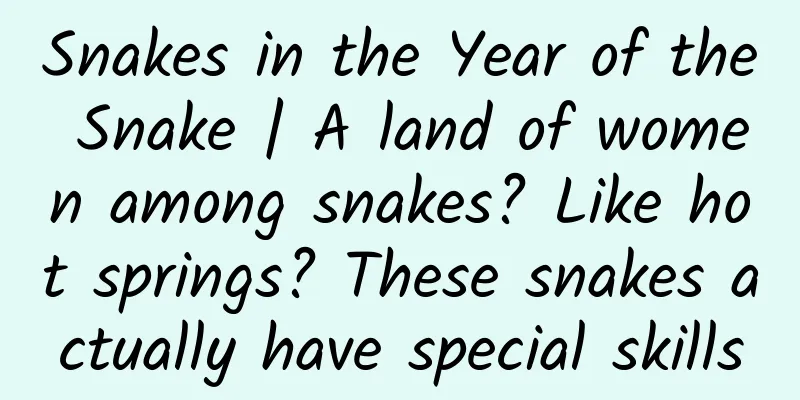Snakes in the Year of the Snake | A land of women among snakes? Like hot springs? These snakes actually have special skills

|
In the Late Jurassic more than 100 million years ago, the dawn snake ( Eophis ) appeared in the world, which is one of the earliest snakes. In the Cretaceous period about 100 million years ago, fossils of snakes without legs appeared in the strata. This animal, which originated from a four-legged lizard, escaped the mass extinction that killed the non-avian dinosaurs and has survived to this day. Restoration of the dawn snake, source: science official website Today, they still roam quietly in every corner of the world, from the cold edge of the Arctic to the scorching tropical rainforest, from the hidden corners of bustling cities to the uninhabited deep mountains and forests. Snakes are writing their own legendary chapters with their unique survival wisdom and wonderful adaptability. Today, let’s take a look at several snakes that have their own “super powers”! 01 The "Kingdom of Daughters" in a flowerpot The Kingdom of Daughters in the story of Journey to the West is well-known. In reality, snakes also have their own "Kingdom of Daughters", that is, the hook-necked blind snake ( Indotyphlops braminus ), which has only females but no males. They give birth to their babies through parthenogenesis and can reproduce several times a year. Each time, they only lay 2-8 eggs. When they are born, the baby snakes are about 5 cm, which is one-third of their mother's body length. Hooked blind snake, image source wikipoint.blog (It’s actually kind of cute?!) The hook-necked blind snake can be seen in many southern provinces of China, and is found in Southeast Asian and South Asian countries abroad. Interestingly, because they are small enough to fit in flower pots, they have spread along with the soil in the flower pots carried by humans to places outside their native distribution areas such as the United States, such as sub-Saharan Africa, Japan, and some areas of Oceania. In the United States, they are even called Hawaiian blind snakes. The body of the hook-shaped blind snake is similar to that of an earthworm, but it has small scales on its body. Its food is various termites and ants. For the hook-shaped blind snake, living in caves is already a common thing. Their eyesight has degenerated in the dark caves, and their round and blunt heads are also suitable for digging . When encountering an enemy, they will choose to flee after emitting a foul smell to protect themselves, and welcome the protection of the earth. Small blind snake Blind snake eating Note: Some snakes are different from the blind snake. They usually reproduce sexually, but sometimes they can reproduce parthenogenetically, such as the red-tailed boa constrictor. In addition, some fish, lizards such as the Komodo dragon, and turkeys among birds also have this phenomenon. 02 A national treasure of the plateau who loves hot springs There is another nationally protected animal in the snake family that likes to soak in hot springs, that is the hot spring snake ( Thermophis ). They live in the Qinghai-Tibet Plateau and its surrounding areas and belong to another family in the snake family, the Colubridae. There are three types of hot spring snakes: Sichuan Hot Spring Snake, Shangri-La Hot Spring Snake and Sichuan Hot Spring Snake. They are all national first-class protected animals. Hot spring snake specimen in Shanghai Natural History Museum, photographed by the author Hot spring snakes are small, usually less than one meter long. But they have a unique skill, which is that they can survive on a plateau at an altitude of 4,000 meters. Hot springs with high altitude and lack of oxygen are their favorite places. They warm themselves up in hot places near hot springs, then enter cold water to prey on fish, frogs, etc. for food. Hot spring snake is hunting Source: "Diet and feeding behavior of the Tibetan hot spring snake, a species endemic to China" In order to adapt to the lack of oxygen and ultraviolet radiation on the plateau, hot spring snakes have a different FEN1 gene from low-altitude snakes to resist ultraviolet radiation. Their mutated EPAS1 gene is also different from that of low-altitude snakes, which can better adapt to the high-altitude and hypoxic environment. The genes related to temperature perception in hot spring snakes have also become special, allowing them to better find hot springs in cold environments. Hot spring snake, source: naturepl.com 03 The giant snake that brought the "Anaconda disaster" If you were to ask what is the largest snake in China? The answer is the Burmese python ( Python bivittatus ), the official Chinese name for this snake is "python". However, among all the snakes in the world, they are not the first. The Burmese python is 3-5 meters long and weighs dozens of kilograms. A Burmese python named "Bao Bao" kept in the zoo weighs more than 180 kilograms and is more than 5.7 meters long. Of course, there are also small ones among them. On some islands in Indonesia, the Burmese python is only more than two meters long, which is related to the lack of food in the local island ecosystem. Burmese python, photographed at Zhengzhou Zoo In China, they are a national second-class protected animal and can be seen in many provinces from Fujian to Hainan and Yunnan. In addition, they are also distributed in Vietnam, Myanmar, Thailand, Indonesia and other countries. The threat level in the wild is Vulnerable (VU) level, and the endangered level is not very high. Burmese pythons are also often kept in captivity and are fairly common in zoos in China. According to a paper published in Scientific Reports last year, researchers used Burmese pythons from farms in Thailand and other places as experimental materials and found that Burmese pythons grow faster and do not need to be fed frequently. The experimental results showed that for every 4.1 grams of food fed to a Burmese python, its weight increased by 1 gram . Based on this research result, some people have suggested that Burmese python meat may become an emerging option for future animal husbandry, and may even become a potential source of modern agricultural reserve grain. Burmese pythons raised in Beijing Wildlife Park, photographed by the author Albino Burmese python lacks black pigment in its body However, the yellow pigment in reptiles is still retained, which is the result of human selection. Photo taken at Tianjin Zoo The Burmese python is a native species that needs attention in China, Thailand and other countries, but it has become a public nuisance in the southern United States. Some Burmese pythons that escaped into the wild after being abandoned by their owners enjoy a humid and warm climate similar to that of their home in Asia, preying on local native animals of all sizes, even juvenile American alligators, North American raccoons ( Procyon lotor ) in cities and farms, and the white-tailed deer that was the prototype of Bambi. Based on local survey reports, Burmese pythons also often eat local cottontail rabbits ( Sylvilagus ), and they even bring other Asian parasites to native snakes, threatening the lives of native snakes. Burmese python caught, source: cbsnews.com This is not a solution. Faced with the python plague in Florida, some people have begun monitoring and capturing Burmese pythons, while others have begun paying attention to which native species in Florida can control them. In field observations, adult American alligators use their large mouths to prey on these invasive species. Local bobcats ( Lynx rufus ) can also prey on python eggs or young Burmese pythons. Thus, these species and local people have begun the process of fighting against the "big snakes". Bobcat prepares to eat python eggs, source: nationalgeographic.com During the five to seven years it takes to reach adulthood, the Burmese python consumes a wide variety of prey in the southern United States. This includes birds like the little blue heron, squirrels, opossums and raccoons. They will also prey on young American alligators. Image source: sfwmd.gov American alligators fight back. Image source: usatoday.com References Polyploidization of Indotyphlops braminus: evidence from isoform-sequencing Khedkar, G., Kambayashi, C., Tabata, H. et al. The draft genome sequence of the Brahminy blindsnake Indotyphlops braminus. Sci Data 9, 410 (2022). https://doi.org/10.1038/s41597-022-01530-z https://www.science.org/content/article/fossils-oldest-known-snakes-unearthed Document Indotyphlops braminus (Daudin, 1803): distribution and oldest record of collection dates in Oceania, with report of a newly established population in French Polynesia (Tahiti Island, Society Archipelago) https://animalia.bio/brahminy-blind-snake GBIF official website LiteratureHighly Competent Native Snake Hosts Extend the Range of An Introduced Parasite Beyond Its Invasive Burmese Python Host Mizuno, T., & Kojima, Y. (2015). A blindsnake that decapitates its termite prey. Journal of Zoology, 297(3), 220-224. O'Shea, M., Kathriner, A., Mecke, S., Sanchez, C., & Kaiser, H. (2013). 'Fantastic Voyage': a live blindsnake (Ramphotyphlops braminus) journeys through the gastrointestinal system of a toad (Duttaphrynus c). Herpetology Notes, 6, 467-470. Natusch, D., Aust, PW, Caraguel, C. et al. Python farming as a flexible and efficient form of agricultural food security. Sci Rep 14, 5419 (2024). https://doi.org/10.1038/s41598-024-54874-4 Ren JL, Yan C, Peng ZL, Li JT*. Sichuan hot-spring snakes imperiled: reason, situation, and protection. Zoological Research. 2022, 43(1):95. doi: 10.24272/j.issn.2095-8137.2021.321. Barker, DG; Barten, SL; Ehrsam, JP & Daddono, L. (2012). "The corrected lengths of two well-known giant pythons and the establishment of a new maximum length record for Burmese Pythons, Python bivittatus" (PDF). Bulletin of the Chicago Herpetological Society. 47 (1): 1–6. Retrieved 2020-03-02. Aglionby, John (2004-01-05) "Stay still, will you?". Guardian. Retrieved on 2012-08-21. Pizzatto, Lígia; Marques, Otavio; Facure, Kátia (2009). "Food habits of Brazilian boid snakes: overview and new data, with special reference to Corallus hortulanus". Amphibia-Reptilia. 30 (4). Brill Publishers: 533–544. doi:10.1163/156853809789647121. ISSN 0173-5373. Literature Comparative genomic investigation of high-elevation adaptation inectothermic snakes The most "alternative": How does a snake live on the Qinghai-Tibet Plateau? ——China Science Daily WeChat https://wiki.biodiversity.cern.ac.cn/index.php/%E9%A6%99%E6%A0%BC%E9%87%8C%E6%8B%89%E6%B8%A9%E6%B3%89%E8%9B%87 Christopher A. Searcy1, Hunter J. Howell1, Aaron S. David2, Reid B. Rumelt1, and Stephanie L. Clements. Patterns of Non-Native Species Introduction, Spread, and Ecological Impact in South Florida, the World's Most Invaded Continental Ecoregion. ANNUAL REVIEW OF ECOLOGY, EVOLUTION, AND SYSTEMATICS Volume 54, 2023. https://doi.org/10.1146/annurev-ecolsys-110421-103104 Lieurance, Deah, Susan Canavan, Donald C. Behringer, Amy E. Kendig, Carey R. Minteer, Lindsey S. Reisinger, Christina M. Romagosa, et al. 2023. “Identifying Invasive Species Threats, Pathways, and Impacts to Improve Biosecurity.” Ecosphere 14(12): e4711. https://doi.org/10.1002/ecs2.4711 The IUCN Red List of Threatened Species. Version 2015-3. <www.iucnredlist.org>. Downloaded on 10 November 2015. Stuart, B., Nguyen, TQ, Thy, N., Grismer, L., Chan-Ard, T., Iskandar, D., Golynsky, E. & Lau, MWN 2012. Python bivittatus (errata version published in 2019). The IUCN Red List of Threatened Species 2012: e.T193451A151341916. https://dx.doi.org/10.2305/IUCN.UK.2012-1.RLTS.T193451A151341916.en. Accessed on 24 January 2025. Hu Xiaolin. Activity patterns and habitat selection of Tibetan hot spring snakes[J]. Journal of Tibet University, 2007, 022(002):77-83,106. Peng Lifang. Molecular systematics of the genus Ophiophagus and description of a new species[D]. Nanjing Forestry University. Wang Xinbo, Li Jiatang, Liu Shaolong, et al. Study on the differences of mitochondrial genes between Tibetan hot spring snakes and Sichuan hot spring snakes [C] Proceedings of the 9th Member Representative Conference and the 10th Academic Seminar of Sichuan Zoological Society. 2011 Author: Daqing Shenlong, student member of Shanghai Science Writers Association Editor: Dong Xiaoxian Reviewer: Zhang Chao, Li Peiyuan |
Recommend
An Air China flight encountered clear sky turbulence, and a passenger and stewardess were thrown to the top of the cabin! Why are planes getting more and more turbulent nowadays?
On July 10, many netizens posted on social media ...
130 million tons of food gap attracts attention? Should families stock up on food to cope with food shortage pressure?
The food issue has always attracted public attent...
Why is there a fine for adding acesulfame potassium, a common beverage, into orange juice?
Recently, another piece of news related to food a...
"Practicing handstand after sex" can "hit the jackpot"? Don't believe these 5 big pitfalls in preparing for pregnancy! Read this if you want to prepare for pregnancy!
Author: Song Qin, deputy chief physician of the D...
Analysis of the underlying logic of the user incentive system!
Background of the User Incentive System The user ...
Changsha high-end tea tasting club, Yuelu District, Yuhua District tea drinking studio
Call 185-6916-1745 for QQ synchronization. It can...
You can make money by posting pictures on Tik Tok! The practical document is worth 1,299 yuan and is full of useful information!
You can make money by posting pictures on Tik Tok...
The "super racetrack" of the microscopic world: China plans to build the world's most powerful "particle bumper car"
Produced by: Science Popularization China Author:...
China Charging Alliance: Operation of national electric vehicle charging and swapping infrastructure in 2021
National Electric Vehicle Charging and Replacemen...
#千万IP创科普# As a bird of prey, it only eats dead things! How did the vulture become a "clear stream" in the bird world?
Vultures are birds of prey but they only eat dead...
Event operation and promotion | Large company event operation process and routines!
Activities are an effective means to drive rapid ...
The counterfeiter is back! Japanese car manufacturers are showing their craftsmanship again, but will they be completely wiped out this time?
Do you remember the various "immortals"...
It's not just the workers who have to compete, the competition for ribosomes is not easy either!
Nowadays, competition is rampant in all walks of ...
Why do I recommend that you really dry your quilt regularly?
Among all animal phobias, spider phobia is defini...
Technology News丨Shenzhou 13 astronauts left the spacecraft today
【Today’s cover】 On December 25, in the Huangshaya...









